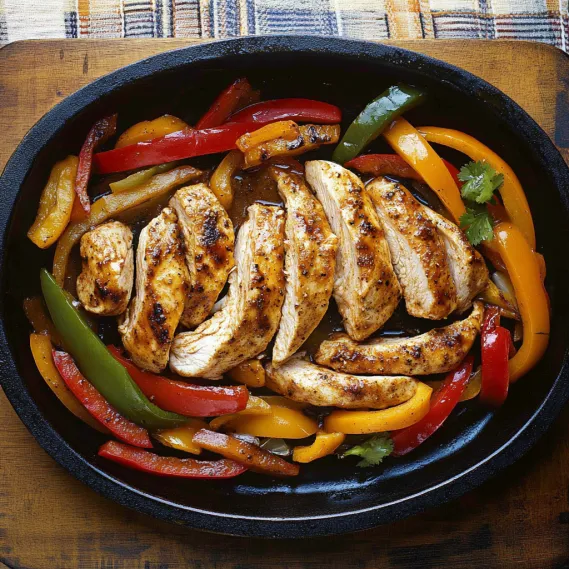 Pin it
Pin it
This hearty chicken fajita recipe transforms simple ingredients into a vibrant, restaurant-quality meal right in your kitchen. The secret lies in a quick but powerful marinade that infuses the chicken with Mexican-inspired flavors before it hits the sizzling pan alongside colorful peppers and onions.
I first made these fajitas during a busy week when I needed something quick yet impressive. My family was so captivated by the sizzling pan and mouthwatering aroma that it's now our Thursday tradition, with everyone gathering to build their perfect fajita.
Ingredients
- Boneless chicken breasts: select pieces that are uniform in size for even cooking
- Bell peppers in various colors: not only beautiful but each color offers slightly different nutrients and flavors
- Large yellow onion: provides essential sweetness when caramelized
- Fresh cilantro: adds bright herbaceous notes that balance the richness
- Jalapeño: brings gentle heat that can be adjusted to your preference
- Fresh lime juice: the acidity tenderizes the chicken and adds authentic flavor
- Cumin and chili powder: these key spices provide the signature fajita profile
- Flour tortillas: look for handmade style for the best texture and flavor
- Toppings like avocado, salsa, and sour cream: these finishing touches make each bite perfect
How To Make The Best Chicken Fajitas
- Prepare the chicken:
- For even cooking slice thicker chicken breasts horizontally to create pieces about half inch thick. This ensures quick cooking and maximum flavor absorption. If your chicken breasts are already thin you can skip this step.
- Create the marinade:
- Combine fresh cilantro, minced jalapeño, garlic, olive oil, lime juice, salt, cumin, and chili powder in a container. This vibrant mixture does double duty by both flavoring and tenderizing the chicken. The acid from the lime begins breaking down proteins while the oil helps carry the flavors deep into the meat.
- Marinate the chicken:
- Add chicken pieces to the marinade ensuring each piece is well-coated. Let sit at room temperature for 30 minutes if you are short on time or refrigerate for up to 8 hours for deeper flavor. This waiting period is crucial as it allows the marinade to work its magic.
- Prep the vegetables:
- While the chicken marries with the marinade, slice onions and peppers into quarter inch strips. Cutting them uniformly ensures they cook at the same rate. Keep the slices substantial enough that they maintain some texture after cooking.
- Sear the chicken:
- Heat oil in a large cast iron skillet until it just begins to smoke. Remove chicken from marinade, pat dry, and season with salt. Place in the hot pan without crowding and let cook undisturbed for 2 to 3 minutes per side. This high heat searing creates a flavorful crust while locking in juices.
- Rest the chicken:
- Transfer seared chicken to a cutting board and cover with foil. Allow it to rest for 5 minutes, which lets the juices redistribute throughout the meat for maximum tenderness. Resting is not optional; it is essential for juicy chicken.
- Cook the peppers and onions:
- Add another tablespoon of oil to the same hot pan then add peppers and onions. The vegetables will pick up all the delicious browned bits from the chicken. Allow them to sear for 2 minutes before stirring then cook another 2 minutes until slightly charred but still crisp.
- Slice and serve:
- Cut the rested chicken across the grain into strips. Serve immediately with the sizzling peppers and onions, warm tortillas, and all your favorite toppings. The presentation of bringing the hot skillet to the table creates an exciting dining experience.
 Pin it
Pin it
The lime juice in this recipe reminds me of my first trip to Mexico where I learned that authentic fajitas always have that bright citrus tang. I was amazed at how such a simple ingredient could transform ordinary chicken into something extraordinary. Now I keep extra limes on hand just for this recipe.
Perfect Temperature Control
Achieving restaurant quality fajitas depends largely on temperature management. Start with an extremely hot pan to get that coveted sear then maintain high heat throughout cooking. If your pan isn't hot enough the chicken will steam rather than sear resulting in less flavor and texture. An infrared thermometer can help you gauge when your pan has reached the ideal temperature of around 450°F before adding the chicken.
Make Ahead Options
Prepare this recipe more efficiently by doing prep work in advance. The marinade can be mixed up to 3 days ahead and stored in the refrigerator. Vegetables can be sliced the day before and stored in airtight containers with a damp paper towel to maintain freshness. You can even cook the entire dish earlier in the day then quickly reheat in a hot skillet just before serving making this perfect for entertaining.
 Pin it
Pin it
Creative Variations
Traditional chicken fajitas are just the beginning. Try substituting flank steak or shrimp for the chicken, each requiring slight adjustments to cooking time. For a vegetarian version, marinate portobello mushrooms in the same mixture and cook them exactly as you would the chicken. Add seasonal vegetables like zucchini in summer or butternut squash in fall to incorporate seasonal flavors. For a low carb option, serve over cauliflower rice or wrapped in large lettuce leaves instead of tortillas.
Cultural Significance
Fajitas originated in the ranch lands of South and West Texas in the 1930s when Mexican ranch workers were given less desirable cuts of beef as part of their pay. These vaqueros developed techniques to make these tough cuts delicious by marinating them in lime juice and cooking them quickly over hot coals. The term fajita actually refers to these specific beef cuts coming from the Spanish word "faja" meaning belt or strip. Today fajitas have evolved beyond their humble beginnings to become a beloved dish across America with chicken versions being particularly popular for their accessibility and shorter cooking time.
Frequently Asked Questions
- → Can I use chicken thighs instead of chicken breasts?
Yes, chicken thighs can be used instead of chicken breasts. They are flavorful and stay moist during cooking. Adjust the cooking time as needed since thighs take slightly longer to cook than breasts.
- → How long should I marinate the chicken?
For best results, marinate the chicken for at least 30 minutes. You can also marinate it for up to 8 hours in the fridge to allow the flavors to deepen.
- → Can the fajitas be made in advance?
While it’s best to cook and serve fajitas fresh, you can prepare the marinade and slice the vegetables ahead of time. Cook the chicken and vegetables just before serving for the best texture and flavor.
- → What are good substitutes for bell peppers?
If you don’t have bell peppers, you can use other vegetables like zucchini, mushrooms, or thinly sliced carrots for a similar texture and vibrant color.
- → What other toppings can I serve with fajitas?
Common toppings include shredded cheese, salsa, avocado, guacamole, pickled onions, or hot sauce. You can also add a side of refried beans or rice for a complete meal.
